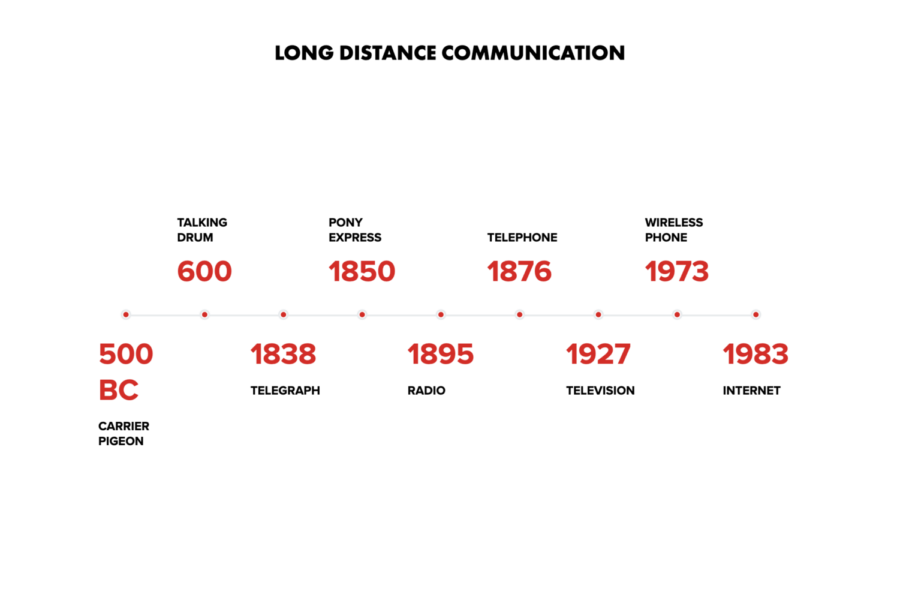The evolution of long distance communication
Jan. 11 is the anniversary of the day the telegraph was introduced to the world. In today’s society, long distance communication is often taken for granted. Your friend moved to another state? You can call her tomorrow. You have a question while working on homework? Just send your teacher an email. But it has taken a long time to get here. Long distance communication began developing thousands of years ago, and it’s come a long way since then. Here’s a brief history of long distance communication.
Carrier pigeons – 500 B.C.
Carrier pigeons have been used for thousands of years – literally. They first came about in 500 B.C., where they were used by Cyrus the Great. Since then, they’ve been used in wars, the Olympic games, to take aerial photographs and to carry newspapers. In fact, in World War I, there was the “Pigeon Corps” that grew to use over 22,000 pigeons. The last pigeon messaging service closed in 2006, marking an end to a millennia of bird brained communication.
Talking drums – 600 A.D.
Talking drums are a type of drum that originated in the Ghana Empire. They mimic the sound of human speech and were first used as a storytelling device for travelling poets and musicians. Later, though, their loud volume shifted their use to communication between villages. Players were taught which beats meant certain words, and messages were sent with both the name of the sender and recipient. Once other forms of long distance communication began becoming more prominent, talking drums reverted back to their original purpose of song and storytelling.
Telegraph – January 11, 1838
The idea of sending electrical signals through wires actually originated in the 1700s, but the telegraph wasn’t invented until the 1830s, when Samuel Morse built a system from Washington D.C. to Baltimore. It took a while to get the entire U.S. connected, but by the 1900s, the telegraph played a role in almost all long distance communication. It completely transformed messaging. Before the telegram was invented, it took weeks or even months to send mail, but now it was possible to send a message across the Atlantic in minutes.
Pony Express – April 3, 1850
Even though the Pony Express was only active for 18 months, it was an incredibly efficient system used to deliver mail over long distances. It was created in America to connect the people who moved to California during the gold rush with the people still living on the East coast. Although telegraphs had already been invented at the time, there was no connection to the western side of the U.S. yet. The Pony Express was operated through a series of relay systems for which one rider would travel about 12 miles to a station where they would switch horses. They rode about 100 miles per day and could travel over 1,000 miles in just over a week. But once telegraph lines were implemented nation-wide, there was no longer a need for the system and it was disbanded.
Telephone – February 14, 1876
Although basic telephones had been created earlier, Alexander Graham Bell first patented the telephone in 1876. After the first telephone wire was created, it only took three years for nearly 50,000 telephones to be in use, and by 1900, that number grew to 600,000. During World War I, telephone lines were spread across the U.S. In 1948, the 30,000,000th phone was put in service. It was an incredibly useful tool for quickly sending private messages by voice, something that hadn’t been possible before.
Radio – 1895
The radio was first invented in 1895 in Italy by Guglielmo Marconi when he sent a message in morse code to someone about a mile away using radio waves rather than wires. Soon, the idea started spreading. Scientists began trying to figure out a way to transmit actual words rather than dots and dashes, and once that hurdle was jumped just before World War I, the radio business boomed. In the 1930s, after the Great Depression was over, the golden age of the radio began, where approximately 80% of people living in the U.S. owned a radio.
TV – September 7, 1927
The first electronic TV was invented by 21-year-old Philo Taylor Farnsworth. He first got the idea for transmitting images through code in high school, and the first image he ever transmitted was a dollar sign. Previously, there had only been mechanical televisions, which were required to be in a completely dark room to work, but by 1934, all TVs became electric. The first TV station popped up in 1928, only a year after the electric television was invented, and another of the earliest television stations, WRGB, is still in operation today.
Wireless Phone – April 3, 1973
Motorola invented the first wireless phone in 1973, and the first ever wireless call was made on April 3 of that year on the DynaTAC 8000X. Even though they had been around for over 15 years, mobile phones only gained popularity in the 1990s. The first text was sent in 1992, which read “Merry Christmas!” and it wasn’t until 1994 that smartphones were invented. Then, in 2007, the iPhone 1 was released, which sparked other still-major companies to release the Android and Galaxy phones.
Internet – Jan 1, 1983
In 1983, the earliest version of the internet was released. It was called TCP/IP, and was a communications protocol that ran on the networks ARPANET and Defense Data. It used dialup phone lines and allowed for people to email across the world. In the mid 1980s, domain names (websites) were first implemented and Apple’s Macintosh was released. The spread of the internet really picked up in the 90s when Microsoft launched Windows 1995 and Java, Internet Explorer and Yahoo were all created. In the 2000s, internet businesses, Google, cat videos and early social media came about.
Now, we have the ability to learn practically anything we want by tapping a few buttons, and can befriend people that live thousands of miles away. Long distance communication may not be something we think about too much, but it surely is something that has completely changed the world.

Junior Heather Wheeler is a reporter and this is her second year on staff. She is a rainy day lover who enjoys birds, chocolate and reading.




Rudi R • Oct 8, 2024 at 7:12 PM
Hi… Why on the chart you put 1895 (radio invented) on the left (earlier) than 1876 (phone) ?